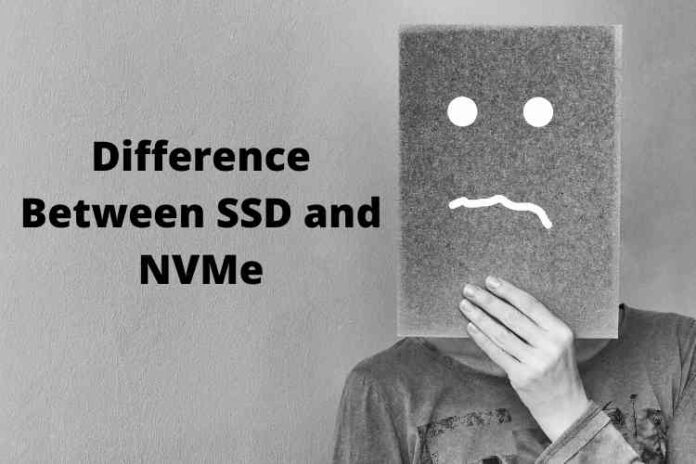With the advancement in Technology now we save our all data and information digitally into our computers and for that, we need storage devices. Storage devices in a computer are very important because they keep a record of the media that is present in the device and also store digital data. These storage devices are integrated within the hardware of the computer and without storage, the normal functioning of the computer would be impossible. Many people must know about SSD and NVMe that Solid State Drives are non-volatile storage devices that use flash memory to store data while NVMe is a software interface that is used to access stored data in a computer.
Although NVMe is far advanced, faster, and better encrypted than SSD, it doesn’t mean that there are no drawbacks in NVMe. So in this article, I will tell you about the Difference Between SSD and NVMe.
RELATED – DIFFERENCE BETWEEN NIKE AND UNDER ARMOUR: KNOW IN DETAIL
About SSD
SSD stands for Solid State Drive which was first introduced by SanDisk. It can also be called a Solid State Device or Solid State Disk. It was introduced in 1991 and at that time, it can only store data up to 20 MB but nowadays these drives can store data around 60-100 TB. These drives cannot be physically damaged easily and are also more resistant to shock. These drives can quickly access data and do not require spinning of the disk to run. Different drives can perform differently according to the number of bits present in one cell. Among these drives, single-cell drives are the fastest, most durable, and more economical. In this article, we are going to discuss OST and PST files and their differences.
Earlier, SSD used the technology of RAM but this is no longer in use because although they were fast, they lost data as soon as the power ran out and this caused a huge loss of data. Therefore, new and more reliable technology was found that is flash memory. When the data is stored in the flash memory of the SSD, it doesn’t lose data when the power runs out but stores it inside the device.
About NVMe
NVMe interface was first developed by NVM express that started ten years ago in 2011. The need to develop the interface came when people found some drawbacks in SSDs. Similar to SSDs, NVMe also has to be physically inserted with the storage media. Unlike SSDs which can carry only one query or command at a time, NVMe can bring results of multiple queries and commands. This also reduces latency and there is a minimum delay when looking for results. They look like 2.5-inch cards that can easily fit into the storage system of the computer.
The first stepping stone for accessing the non-volatile memory came out at the Intel Developer Forum in 2007 and was completed by 2008 and released on Intel’s website. More than 90 companies took part in making the specifications of NVMe. Integrated Device Technology made the NVMe commercially successful and available to the general public in August 2012.
Main Differences between SSD and NVMe
The main difference between SSD and NVMe is that SSD stores data by using integrated circuits while NVMe is an interface that is used to access the stored data at a high speed and NVMe is more advanced than SSD. The following are some differences mentioned below that will make you clear about SSD and NVMe:
- SSD stands for Solid Storage Device while NVMe stands for non-volatile memory express.
- SSD is a secondary storage device that uses integrated circuits to complete the work while NVMe is an interface that is used to access the stored data.
- NVMe works much faster than SSDs as they can transfer data 25 times faster.
- Solid State Drives require less power to function while NVMe uses more power.
- NVMe is much more expensive while SSDs are cheaper.
- SSD is slower to access and gives results at the speed of 600 MB per second. In comparison to NVMe, it provides more room for storage at a lower price and can be connected to any device as it is compatible with all devices. SSDs are more power-efficient than NVMe as they can run on low power.
- SSDs are compatible and can be connected to any device easily while it is not the same for NVMe as it does not fit SATA ports and needs an M.2 port.
- NVMe is better encrypted in comparison to SSDs as NVMe provides industry-standard security solutions.
- SSDs have the read-write speed of 600 MB per second while NVMe has the read-write speed of 2000 MB.
- Another basic difference is SSDs are a part of hardware while NVMe is software that can be installed into the computer.
The Final Words
Storage devices are of no use if there is no way to access the data, here comes the need for NVMe. NVMe is fast and efficient software that reads the data at the speed of 3 GB per second and is four times faster than the fastest SAS (Statistical Software Suite). It can give results at the speed of 2000 MB per second.
SSD is slower to access and gives results at the speed of 600 MB per second. In comparison to NVMe, it provides more room for storage at a lower price and can be connected to any device as it is compatible with all devices. SSDs are more power-efficient than NVMe as they can run on low power.
Both SSDs and NVMe are great to use as they both have their advantages and disadvantages. So I hope this article was helpful and you have got the difference between SSD and NVMe so can choose the perfect fit for you.






















